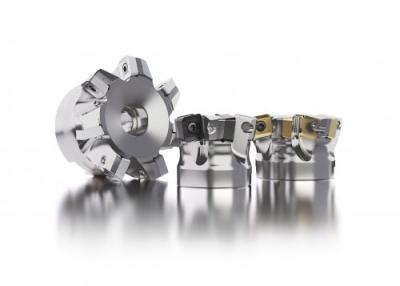
Seco Tools has launched a new High Feed cutter and insert series in size 14. Increase tool life and maximize the value of every edge with this new series in stainless steels, titanium, and superalloys milling applications. The High Feed Square Cut size 14 milling system is ideal for tough materials and comes in a full range of proven Seco Tools grades made to achieve fully secure, and optimized high feed milling.
The single-sided, straight edge insert geometries allow you to push your high feed milling speeds to new limits. Ensuring high feed per tooth whether ramping, pocketing, plunging, or performing face or copy milling, this new solution creates great chip evacuation and makes it easier than ever or handle difficult machining operations or milling in deep cavities.
Not only does this solution make it easier to machine sticky materials, but it is designed for easy, ergonomic indexing and the pocket and screw designs simplify positioning. The cutters themselves feature a new environmentally friendly coating and their outstanding high feed milling performance reduces the amount of power used in roughing. Yet another step in the right direction for Seco Tools to continue their journey to create more environmentally sustainable manufacturing and machining solutions.
Contact Details
Related Glossary Terms
- feed
feed
Rate of change of position of the tool as a whole, relative to the workpiece while cutting.
- gang cutting ( milling)
gang cutting ( milling)
Machining with several cutters mounted on a single arbor, generally for simultaneous cutting.
- milling
milling
Machining operation in which metal or other material is removed by applying power to a rotating cutter. In vertical milling, the cutting tool is mounted vertically on the spindle. In horizontal milling, the cutting tool is mounted horizontally, either directly on the spindle or on an arbor. Horizontal milling is further broken down into conventional milling, where the cutter rotates opposite the direction of feed, or “up” into the workpiece; and climb milling, where the cutter rotates in the direction of feed, or “down” into the workpiece. Milling operations include plane or surface milling, endmilling, facemilling, angle milling, form milling and profiling.
- stainless steels
stainless steels
Stainless steels possess high strength, heat resistance, excellent workability and erosion resistance. Four general classes have been developed to cover a range of mechanical and physical properties for particular applications. The four classes are: the austenitic types of the chromium-nickel-manganese 200 series and the chromium-nickel 300 series; the martensitic types of the chromium, hardenable 400 series; the chromium, nonhardenable 400-series ferritic types; and the precipitation-hardening type of chromium-nickel alloys with additional elements that are hardenable by solution treating and aging.
- superalloys
superalloys
Tough, difficult-to-machine alloys; includes Hastelloy, Inconel and Monel. Many are nickel-base metals.

